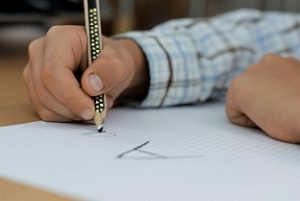Some Children Can’t Write, Post
- On Apr, 14, 2023
- Tutoring Primary
- Blog
Some Children Can’t Write
Some Children Can’t Write but they can improve!
Links: Upper Primary School, Page, Middle Primary School, Page , Early Primary School, Page, Early Secondary School, Page. These pages give you an overview of Tutoring Primary and many links to products.
What affects people’s ability to write? This question includes “what affects children’s ability to write?” Maybe:
- ADHD
- Developmental Language Disorder (DLD); or
- Aspergers (first level of autism).
Learning difficulties can mean Some Children Can’t Write. In this post, the theme is teachers may be able to do better. More teaching. More instruction. This means less time spent on other topics.
Schools need to agree on a writing style and model that style. Teachers need to use the accepted style and do it in the classroom! And some don’t. Modelling handwriting has been downgraded along with handwriting itself.
>More of the brain is active when writing in script than when hand printing.
>>More of the brain is used in hand printing than when using a keyboard.Link to follow this up: Handwriting – An Intellectual Activity, Post
But parents can help a lot. The National Handwriting Association (UK) has some free items to download with great suggestions. https://nha-handwriting.org.uk/ .
There are good resources on the internet that parents can take advantage of. Here is one. https://www.theottoolbox.com/handwriting/
Here are step-by-step instructions and other helpful hints for use in the home.
How to Teach Hand-Printing, Post Teaching Handwriting, Post
Many children with these learning difficulties can speak well. They understand what is said and join in conversations. And these children can follow the lessons despite distractions around them.
But it is the writing skills that do not develop. Children need several skills in primary school for writing. These all interact with each other. The skill of recalling is important for:
- how a letter is formed and where the starting point is, and
- which letter comes first or second.
- Then work towards the recalling letter bundles, such as ai words or oo words.
In early grades, there is not much modelling of letter formation . Whiteboards have become very small. Using electronic whiteboards is a great idea but could be used more. Children see the finished letter and so they write a letter to look like it.
For example, they see a finished handwritten ‘a’ and write an ‘o’ with a tail on it. On the left is a correctly written a and on the right is the o with a tail. A common problem! 
Many children write ‘f’ upwards. It looks right when finished.
- Later on, they are unable to write joined script so they may be left behind in tests and writing tasks at high school.
- They write, on average, about half what other children write if they continue to hand-print.
So for those children with learning difficulties, this lack of instruction makes their learning challenges greater.
By Grade 4, catching up is harder. Anxiety, also a symptom of some learning disorders, can set in. The child is unhappy and stressed. All this can be avoided with effective instruction in the early grades. Instruction of letter formation should continue into Grade 3 and 4 for these children.
Fair dealing/use claimed on pictures.